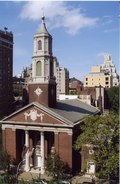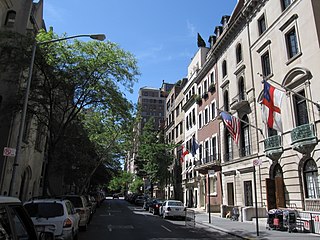
The Upper East Side, sometimes abbreviated UES, is a neighborhood in the borough of Manhattan in New York City, bounded approximately by 96th Street to the north, the East River to the east, 59th Street to the south, and Central Park and Fifth Avenue to the west. The area incorporates several smaller neighborhoods, including Lenox Hill, Carnegie Hill, and Yorkville. Once known as the Silk Stocking District, it has long been the most affluent neighborhood in New York City.

Rodef Shalom Congregation is an historic Reform Jewish congregation and synagogue located at 4905 Fifth Avenue, Pittsburgh, Pennsylvania, in the United States. The landmark building was designed by architect Henry Hornbostel and completed in the Beaux-Arts style.

St. Michael's Church is a historic Episcopal church at 225 West 99th Street and Amsterdam Avenue on Manhattan's Upper West Side in New York City. The parish was founded on the present site in January 1807, at that time in the rural Bloomingdale District. The present limestone Romanesque building, the third on the site, was built in 1890–91 to designs by Robert W. Gibson and added to the National Register of Historic Places in 1996.

The Church of St. Vincent Ferrer is a Catholic parish in the Upper East Side of Manhattan, New York City. It was built in 1918 by the Dominicans; the attached priory serves as the headquarters of the Eastern United States Province of the order. Its architecture has some unusual features: above the front entrance is one of the few statues of the Crucifixion on the exterior of an American Catholic church; and inside, the Stations of the Cross depict Christ with oil paintings instead of statuary or carvings. It has two Schantz pipe organs. The church building, at the corner of Lexington Avenue and East 66th Street in the Lenox Hill section of the Upper East Side, has been called "one of New York's greatest architectural adornments."

The Park Avenue Christian Church is a joint Disciples of Christ and United Church of Christ church located at 1010 Park Avenue at 85th Street, on the Upper East Side of Manhattan, in New York City, New York, in the United States. The Rev. Kaji S. Douša has served as Senior Pastor since 2016. She is the first woman and the first Black woman to be called to this role, the second African-American after the Rev. Alvin Jackson, Pastor Emeritus.

Brown Memorial Park Avenue Presbyterian Church of Baltimore, Maryland, U.S., is a large, Gothic Revival-style church built in 1870 and located at Park Avenue and Lafayette Avenue in the city's Bolton Hill neighborhood. Named in memory of a 19th-century Baltimore financier, the ornate church is noted for its exquisite stained glass windows by artist Louis Comfort Tiffany, soaring vaulted ceiling, and the peo0le associated with its history. Maltbie Babcock, who was the church's pastor 1887–1900, wrote the hymn This is My Father's World. Concert performer Virgil Fox was organist at Brown Memorial early in his career (1936–1946).
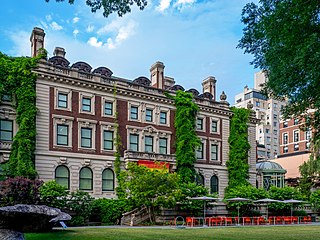
The Andrew Carnegie Mansion is a historic house and a museum building at 2 East 91st Street, on the east side of Fifth Avenue, in the Upper East Side of Manhattan in New York City. The three-and-a-half story, brick and stone mansion was designed by Babb, Cook & Willard in the Georgian Revival style. Completed in 1902 for the industrialist Andrew Carnegie, his wife Louise, and their only child Margaret, it served as the family's residence until 1946. Since 1976, the house has been occupied by the Cooper-Hewitt Museum, part of the Smithsonian Institution. The mansion is internally connected to two townhouses at 9 East 90th Street and 11 East 90th Street, both of which are part of the Cooper-Hewitt.

Fifth Avenue Presbyterian Church is a Presbyterian Church (U.S.A.) church in New York City. The church, on Fifth Avenue at 7 West 55th Street in Midtown Manhattan, has approximately 2,200 members and is one of the larger PCUSA congregations. The church, founded in 1808 as the Cedar Street Presbyterian Church, has been at this site since 1875.
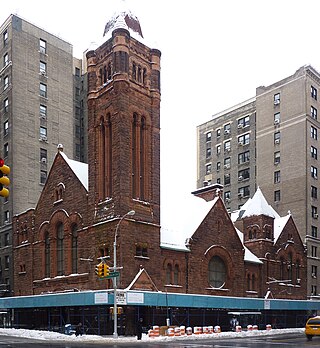
West-Park Presbyterian Church is a Romanesque Revival Presbyterian church located on the corner of Amsterdam Avenue at 86th Street on the Upper West Side of Manhattan in New York City. It consists of a main sanctuary and chapel.

Madison Square Presbyterian Church was a Presbyterian church in Manhattan, New York City, located on Madison Square Park at the northeast corner of East 24th Street and Madison Avenue. It was designed by Stanford White in a High Renaissance architectural style, with a prominent central dome over a cubical central space in an abbreviated Greek cross plan; it was built in 1906. The inaugural service was on October 14 of that year. The congregation's church had previously been located on the opposing, southeast corner of Madison and 24th Street, in a Gothic-style structure, also called the "Madison Square Presbyterian Church", whose cornerstone was laid in 1853 and which was completed the following year. Metropolitan Life Insurance Company purchased the original site for the construction of the Metropolitan Life Insurance Company Tower, a 48-story building completed in 1909 which was the world's tallest building when it was constructed.

First Presbyterian Church is located in central Davenport, Iowa, United States. It was listed on the National Register of Historic Places in 1983. The congregation is associated with the Presbyterian Church (USA).
West Presbyterian Church was a congregation and two houses of worship in Manhattan, New York City. The congregation was founded in 1829 and merged in 1911 with Park Presbyterian Church to form West-Park Presbyterian Church. The first house of worship, also known as the Carmine Street Presbyterian Church, in Greenwich Village, was used from 1832 to 1865, and the second, on West 42nd Street between Fifth Avenue and Sixth Avenue, from 1865 until 1911, when it was sold and demolished. Proceeds from the sale were used, in accordance with the merger agreement, to build and endow a church for an underserved neighborhood, Washington Heights: Fort Washington Presbyterian Church. In addition, the West Church congregation had earlier established two mission churches which eventually merged to become Good Shepherd-Faith Presbyterian Church. West-Park, Fort Washington, and Good Shepherd-Faith are all active today.
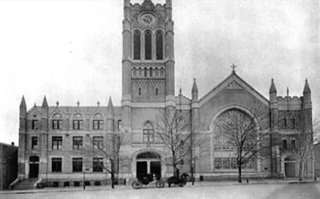
The congregation of North Presbyterian Church, at 525 West 155th Street in Manhattan, New York City, is a combination of three former congregations: North Presbyterian Church, Washington Heights Presbyterian Church, and St. Nicholas Avenue Presbyterian Church.

The Fourth Presbyterian Church of Chicago is one of the largest congregations of the Presbyterian Church (U.S.A.), located in the Magnificent Mile neighborhood of Chicago, directly across Michigan Avenue from the John Hancock Center.

Knox-Metropolitan United Church stands on Lorne Street at Victoria Avenue across from Victoria Park in downtown Regina, Saskatchewan, Canada. It is the current manifestation of Presbyterian and Methodist congregations that date back to "worship services in both traditions…in 1882."
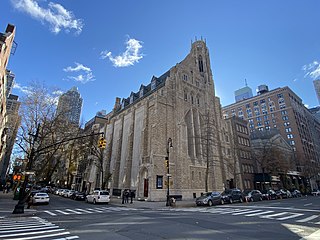
Central Presbyterian Church is a historic congregation on the Upper East Side of Manhattan in New York City, founded by pastor and abolitionist William Patton in 1821. It is a member of the Evangelical Presbyterian Church, and it worships in a Gothic Revival structure completed in 1922 that was originally commissioned and largely funded by John D. Rockefeller Jr. as Park Avenue Baptist Church.
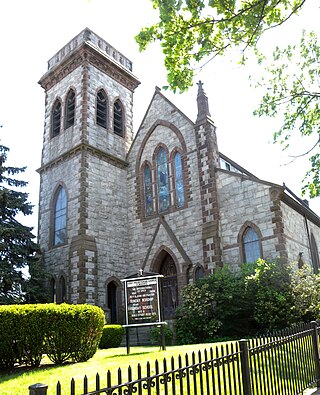
The First Presbyterian Church of Newtown is a historic Presbyterian church in the Elmhurst neighborhood of Queens in New York City. The church complex is composed of the main church, a parish hall, and a manse. The current complex at 54th Avenue, between Seabury Street and Queens Boulevard, is the fifth church complex built for the congregation.

Madison Avenue Presbyterian Church (MAPC) is a congregation of the Presbyterian Church (USA). It is located at East 73rd Street and Madison Avenue on the Upper East Side of Manhattan in New York City.

The Coignet Stone Company Building is a historical structure in the Gowanus neighborhood of Brooklyn in New York City, at the intersection of Third Street and Third Avenue. Designed by architects William Field and Son and constructed between 1872 and 1873, it is the city's oldest remaining concrete building. The Coignet Building is the last remaining structure of a five-acre concrete factory complex built for the Coignet Agglomerate Company along the Gowanus Canal.
